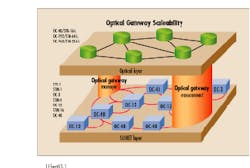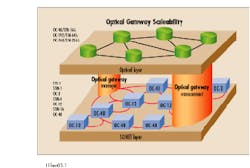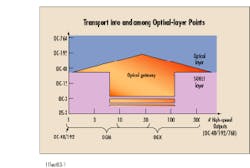Optical layer versus optical networks: Is there a difference?
Optical layer versus optical networks: Is there a difference?
CARMEN D. WEBB, Alcatel
Emerging SONET elements will be required to unleash the potential of photonic network elements.
The terms "optical layer" and "optical networks" have sometimes been inaccurately applied. The network elements in the optical layer are true photonics-derived equipment. Today, these optical-layer network elements are limited to dense wavelength-division multiplexing (DWDM) devices and optical amplifiers, which as standalone equipment, lend limited promise for new carrier services. Although photonic technology developments are being directed toward this emerging optical layer to enable more efficient network restoration, wavelength grooming, and, ultimately, end-to-end wavelength-based services, the optical technologies required are not yet available.
Optical Networks are sometimes seen as consisting of only photonic products without considering the growing number of high-bit-rate optical interfaces on traditional Synchronous Optical Network (SONET) central office elements. For networks to become more efficient and to support new services, carriers will require a combination of both optical-layer network elements and new or enhanced SONET layer elements for the "all-optical network."
The dilemma
Wavelength-division multiplexing (WDM) is used in the network to relieve the bottlenecks of fiber congestion. It is a technology that has been primarily implemented by interexchange carriers to satisfy their need for more bandwidth. That`s where the real economic prove-in came through its use in conjunction with optical amplifiers to reduce the cost of regeneration in coast-to-coast networks. But regeneration is less of an issue in the local-exchange network, and in many cases conduit exists to pull more fiber as a lower-cost alternative to deploying a WDM system.
Thus, the argument for WDM as simply a network infrastructure tool is not as compelling for metropolitan or other short-haul networks. It must have more benefit to the operator to gain acceptance into the network. It is the appearance of wavelengths in both long-haul and access networks that opens new revenue-generating service opportunities.
Some may assume that all-photonic elements will be necessary to realize leased wavelength services from one access network across the optical backbone to another access network. They see concepts currently being applied to the electrical domain--such as time slot assignment and interchange, survivable ring switching, and mesh network restoration--as migrating to optical-layer elements. But even AT&T sees traditional elements as part of the network`s future. "SONET will continue to be the transport architecture well into the 21st century, but the levels [to which] you can take it with dense wavelength-division multiplexing are the key," said Frank Ianna, executive vice president of AT&T Network and Computing Services, in Telephony (June 17, 1998).
A combination of SONET and photonic technologies is needed because the necessary photonic technology does not yet exist that would enable the backbone to handle the required bit-rate transparency due to the lack of "all-optical" regeneration capabilities. Additionally, carriers may not want complete bit-rate transparency because of the potential network cost inefficiencies. This dilemma can be solved with a transition gateway SONET element that can provide the ability to groom electrical and lower-rate optical services into an aggregate high-speed signal to deliver to the backbone optical layer.
SONET solutions
Where optical-layer backbone and access networks interconnect, a new network element category, optical gateways, will emerge to provide efficient traffic management between these two networks (see Fig. 1). The optical gateway is a necessary element of true optical networking, providing a platform with integrated DWDM optics while internally managing broadband services in the electrical domain. Gateways become the bridge between flexible access networks and highly efficient backbone networks.
Two types of gateways will emerge in the near future: optical gateway crossconnects (OGXs) and optical gateway managers (OGMs). Optical gateways will manage the transparent-to-opaque conversion between the access and long-haul networks and manage the broad range of payloads in wavelength services. They will simultaneously support cell-based routing and aggregation of Asynchronous Transfer Mode (ATM) or Internet protocol (IP) payloads and legacy STM services. In this way, lower-rate wavelengths from the access will be aggregated to high-speed channels compliant with the International Telecommunications Union grid for the backbone network. These gateway functions provide for optimized bandwidth utilization. And as DWDM systems grow in channel count (currently projected up to 240 channels per fiber), optical gateways will emerge as the central wavelength service management device.
The optical gateway manager provides the entry points into the backbone optical layer, where the OGX manages transitions between interconnected optical-layer networks. The OGM is used in intermediate locations between OGXs to terminate optical-layer services. It is used at the edges of the optical layer to aggregate a mixture of cell-based or STM-based services and can be used in place of the OGX in lower-density networks of less than 10 OC-192s (10 Gbits/sec). The primary architectural difference between a gateway manager and a crossconnect is the number of optical channels supported on each product (see Fig. 2).
Optical-layer solutions
As the optical layer emerges to support the new demands of a data-oriented network through wavelength-based service offerings, new kinds of network elements will be required. In the access networks, low-cost enterprise multiplexers with direct wavelength interfaces will be required to provide low-cost connectivity to the end customer. These elements will support variable-rate optical interfaces, capable of accepting a broad range of data rates, from 100 Mbits/sec up to 2.5 Gbits/sec, and each wavelength will be path protected. These are the products carriers need to support the business case for wavelength-based services. Today, products that were optimized for backbone applications are being force-fitted into these applications through minor cost reductions. But to adequately address the access market, optical-layer products are required that are optimized specifically for these applications with low-cost, highly robust WDM architectures.
In the backbone network, new optical add/drop multiplexers will appear that support wavelength-level add/drop functionality and optical-layer 4-fiber bidirectional line-switched rings. In addition, the number of wavelengths will increase from 40 to more than 200 and the bit rate per channel will increase from 2.5 to 10 Gbits/sec and beyond. Optical add/drop multiplexers capable of managing several terabits of bandwidth are on the horizon.
All-optical future
The appearance of the managed wavelength has presented some fascinating new opportunities for carriers in all segments of the network. The goal is to take full advantage of the emerging optical network to enable high-revenue end-to-end wavelength-based services. Many other telecommunications market segments are rallying around this optical office concept, as ATM switches and IP routers push into the public network with direct optical interfaces and large core network products engulf SONET interfaces and multiple switch fabrics to handle a range of services.
The all-optical network is a not a manufacturers` strategy to sell more equipment but truly a combination of new efficient photonic products and new SONET products with all-optical interfaces. These solutions will meet the demands of tomorrow`s end user. u
Carmen D. Webb is manager of new business development for Alcatel`s Core Transport Products (Richardson, TX). Alcatel`s Web site is www.usa.alcatel.com.Fig. 2. Different traffic densities require different pieces of equipment. Managers provide efficient transport in low-density applications, whereas higher traffic densities will require a crossconnect.


